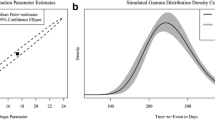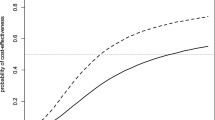Abstract
The incremental cost-effectiveness ratio (ICER) is a well accepted measure of cost-effectiveness in health sciences. Due to the complexity of a ratio of random variables, constructing an appropriate confidence interval for the ICER is challenging. Many methods have been proposed, yet systematic comparisons of these methods are rare. Also, there have been conflicting recommendations for the optimum methodology. Polsky et al. (Health Econ. 6:243–252, 1997) and Briggs et al. (Stat. Med. 18:3245–3262, 1999) have performed simulation studies comparing four and eight methods, respectively. Cook and Heyse (Stat. Med. 19:2989–3003, 2000) have proposed an angular transformation for addressing the problem of improper ordering of ICER estimates using bootstrap resampling, and compared several methods with and without the transformation. In this paper we have conducted an extensive simulation to compare the most commonly used methods as well as new methods that have not yet been evaluated in the aforementioned simulation studies. We simulated samples from a wide range of distributions, and considered the less desired scenarios when the true standardized incremental effect was near zero. The results suggest that confidence intervals based on Fieller’s method, bootstrap-percentile method, and bootstrap-standard method consistently yield reasonable coverage percentages across different sample distributions. Other methods depend heavily on sample sizes, as well as how far the standardized incremental effect is away from zero. Confidence intervals based on the transformed methods are exceptionally problematic when the standardized incremental effect is small. We have also illustrated our results with a real example.


Similar content being viewed by others
References
Briggs, A.H., Mooney, C.Z., Wonderling, D.E.: Constructing confidence intervals for cost-effectiveness ratios: an evaluation of parametric and non-parametric techniquest using Monte Carlo simulation. Stat. Med. 18, 3245–3262 (1999)
Buonaccorsi, J.P., Iyer, H.K.: A comparison of confidence regions and designs in estimating a ratio. Commun. Stat. Simulat. 13, 723–741 (1984)
Chaudhary, M.A., Stearns, S.C.: Estimating confidence intervals for cost-effectiveness ratios: an example from a randomized trial. Stat. Med. 15, 1447–1458 (1996)
Cook, J.R., Heyse, J.F.: Use of an angular transformation for ratio estimation in cost-effectiveness analysis. Stat. Med. 19, 2989–3003 (2000)
Cox, C.: Fieller’s theorem, the likelihood and the delta method. Biometrics 46, 709–718 (1990)
Efron, B.: Better bootstrap confidence intervals. J. Am. Stat. Assoc. 82, 171–185 (1987)
Efron, B., Tibshirani, R.J.: An introduction to the bootstrap. Chapman & Hall/CRC (1993)
Fieller, E.C.: Some problems in interval estimation. J R Stat Soc [Ser B] 16, 175–183 (1954)
Hahn, S., Whitehead, A.: An illustration of the modelling of cost and efficacy data from a clinical trial. Stat. Med. 22, 1009–1024 (2003)
Hall, P., Martin, M.: On the bootstrap and two-sample problems. Austral. J. Statist. 30A, 179–192 (1988)
Heitjan, D.F., Moskowitz, A.J., Whang, W.: Bayesian estimation of cost-effectiveness ratios from clinical trials. Health Econ. 8(3), 191–201 (1999)
Heitjan, D.F., Moskowitz, A.J., Whang, W.: Problems with interval estimates of the incremental cost-effectiveness ratio. Med. Decis. Making 19(1), 9–15 (1999)
Hwang, J.T.G.: Fieller’s problems and resampling techniques. Statistical Sinica 5, 161–171 (1995)
Jiang, G., Wu, J., Williams, G.R.: Fieller’s interval and the bootstrap-fieller interval for the incremental cost-effectiveness ratio. Health Serv. Outcomes Res. Methodol. 1, 291–303 (2000)
Miller, R.J. Jr.: Beyond Anova, basics of applied statistics. John Wiley, New York (1986)
Katon, W.J., Roy-Byrne, P., Russo, J., Cowley, D.: Cost-effectiveness and cost offset of a collaborative care intervention for primary care patients with panic disorder. Arch. Gen. Psychiatry 59(12), 1098–1104 (2002)
O’Brien, B.J., Drummond, M.F., Labelle, R.J., Willan, A.: In search of power and significance: issues in the design and analysis of stochastic cost-effectiveness studies in health care. Med. Care 32, 150–163 (1994)
O’Brien, B.J., Briggs, A.H.: Analysis of uncertainty in health care cost-effectiveness studies: an introduction to statistical issues and methods. Stat. Methods Med. Res. 11, 455–468 (2002)
Polsky, D., Glick, H.A., Willke, R., Schulman, K.: Confidence intervals for cost-effectiveness ratios: a comparison of four methods. Health Econ. 6, 243-252 (1997)
Roy-Byrne, P., Katon, W., Cowley, D.S., Russo, J.: A randomized trial of collaborative care for patients with panic disorder in primary care. Arch. Gen. Psychiatry 58(9), 869–876 (2001)
Sitter, R.R., Wu, C.F.J.: On the accuracy of Fieller intervals for binary response data. J. Am. Stat. Assoc. 88, 1021–1025 (1993)
Sykes, A.M.: Ratio estimates and Fieller’s theorem in regression modelling. Commun. Stat. Theor. 29, 2055–2063 (2000)
Wakker, P., Klaassen, M.P.: Confidence intervals for cost/effectiveness ratios. Health Econ. 4, 373–381 (1995)
Yee, K.F.: The calculation of probabilities in rejecting bioequivalence. Biometrics 42, 961–965 (1986)
Zerbe, G.O.: On Fieller’s theorem and the general linear model. Am. Stat. 32, 103–105 (1978)
Acknowledgements
This work is supported in part by NIH grant AHRQ R01HS013105-01 and grants from the John A. Hartford Foundation.
We are grateful to Drs. Jürgen Unützer, Joan Russo, and Wayne Katon for their helpful and insightful comments. We also would like to thank Dr. Roy-Byrne for generously providing his data.
Author information
Authors and Affiliations
Corresponding author
Rights and permissions
About this article
Cite this article
Fan, MY., Zhou, XH. A simulation study to compare methods for constructing confidence intervals for the incremental cost-effectiveness ratio. Health Serv Outcomes Res Method 7, 57–77 (2007). https://doi.org/10.1007/s10742-006-0017-9
Received:
Revised:
Accepted:
Published:
Issue Date:
DOI: https://doi.org/10.1007/s10742-006-0017-9




